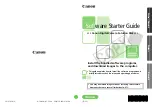
Coexistence and Migration Issues
4
no
vd
ocx (
E
NU)
01
F
ebr
ua
ry
200
6
41
4
Coexistence and Migration Issues
One of the top priorities in designing Novell
®
iFolder
®
3.
x
was to ensure that new iFolder services,
running on Novell Open Enterprise Server, can be introduced into an existing network environment
without disrupting existing Novell iFolder 2.1
x
services.
This section discusses the following the issues:
•
Section 4.1, “Coexistence of iFolder 3.x and 2.1x Servers,” on page 41
•
Section 4.2, “Coexistence of the iFolder Client with Novell iFolder 1.x and 2.x Clients,” on
page 42
•
Section 4.3, “Migrating from iFolder 2.1x to 3.x Server,” on page 42
•
Section 4.4, “Migrating User Files from an iFolder 2.1x to a 3.x Server,” on page 42
4.1 Coexistence of iFolder 3.
x
and 2.1
x
Servers
If you use both Novell iFolder 3.
x
and iFolder 2.1
x
servers, we recommend that you install each
version on its own dedicated server. However, iFolder 3.
x
enterprise and Web access servers can
coexist with an iFolder 2.1
x
server on an OES Linux computer under the following conditions:
• Both iFolder 3.
x
and iFolder 2.1
x
run Apache 2 Worker. However, iFolder 2.1
x
runs a special
configuration of Apache 2 Worker where the number of threads is limited. iFolder 3.
x
runs with
the default Apache 2 Worker configuration that comes with OES. The separate instances of
Apache run in parallel, with no interaction between them.
• You must use different IP addresses for the iFolder 3.
x
enterprise server and the iFolder 2.1
x
server running on the same computer. The iFolder 3.x enterprise server and iFolder 3.x Web
access server share the same IP address when they are on the same server.
• The processor, memory, network adapter, and storage disks on the computer must be sized to
support the combined workload and storage requirements for the iFolder servers.
• iFolder 3.
x
and 2.1
x
are not integrated in any way.
• They are different software packages and share no files in common.
• They use different methods and settings for management, security, policies, data storage,
user provisioning, Web access, and backup.
• They do not share or coordinate information about servers, LDAP, administrators, users,
or iFolders.
• There are no storage economies for or coordination of iFolder files and data.
• Users must use each server’s corresponding iFolder client to access their iFolder data on
that server.
• Users must use the corresponding access method to access their iFolder data via a Web
browser. iFolder 3.
x
requires the iFolder 3.
x
Web access server, and iFolder 2.1
x
requires
Novell NetStorage.
For more information, see
Section 2.4, “Comparison of 2.1x and 3.x Server Features and
Capabilities,” on page 22
.
Содержание IFOLDER 3 - ADMINISTRATION
Страница 4: ...novdocx ENU 01 February 2006...
Страница 10: ...10 Novell iFolder 3 x Administration Guide novdocx ENU 01 February 2006...
Страница 30: ...30 Novell iFolder 3 x Administration Guide novdocx ENU 01 February 2006...
Страница 40: ...40 Novell iFolder 3 x Administration Guide novdocx ENU 01 February 2006...
Страница 44: ...44 Novell iFolder 3 x Administration Guide novdocx ENU 01 February 2006...
Страница 50: ...50 Novell iFolder 3 x Administration Guide novdocx ENU 01 February 2006...
Страница 66: ...66 Novell iFolder 3 x Administration Guide novdocx ENU 01 February 2006...
Страница 80: ...80 Novell iFolder 3 x Administration Guide novdocx ENU 01 February 2006...
Страница 102: ...102 Novell iFolder 3 x Administration Guide novdocx ENU 01 February 2006...
Страница 108: ...108 Novell iFolder 3 x Administration Guide novdocx ENU 01 February 2006...
Страница 124: ...124 Novell iFolder 3 x Administration Guide novdocx ENU 01 February 2006...
Страница 140: ...140 Novell iFolder 3 x Administration Guide novdocx ENU 01 February 2006...
















































